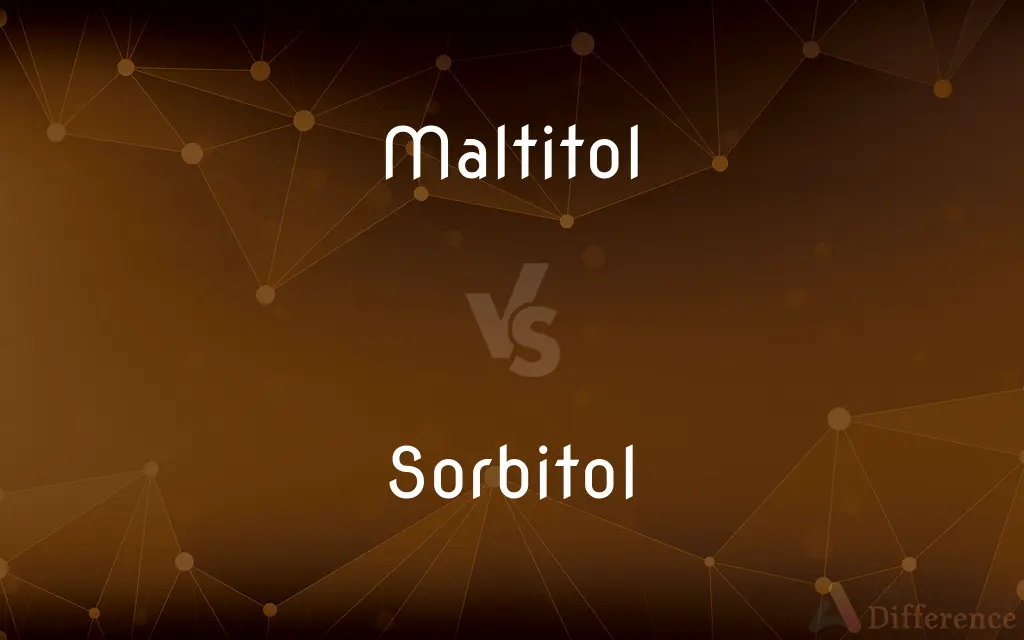Maltitol vs. Sorbitol — What's the Difference?
By Tayyaba Rehman — Updated on November 6, 2023
Maltitol is a sugar alcohol with a similar sweetness to sugar, used as a low-calorie sweetener, while sorbitol is less sweet and often used in sugar-free products.

Difference Between Maltitol and Sorbitol
Table of Contents
ADVERTISEMENT
Key Differences
Maltitol is a sugar substitute, a type of sugar alcohol that is almost as sweet as sucrose but with fewer calories. Sorbitol, another sugar alcohol, has approximately 60% of the sweetness of sucrose and also provides fewer calories. Both are often used in "sugar-free" or "no sugar added" products.
Maltitol's sweetness allows it to replace sugar in a 1:1 ratio for many applications, which makes it a preferred choice in a variety of food products. Sorbitol, being less sweet, is sometimes combined with other sweeteners to achieve the desired sweetness, especially in confectionery and chewing gums.
In terms of digestion, maltitol is partially absorbed by the body and has a lesser effect on blood sugar levels than regular sugar, making it suitable for diabetic-friendly diets. Sorbitol has a similar effect but is better known for its ability to retain moisture and is, therefore, also used as a humectant in cosmetics.
Maltitol may have a laxative effect if consumed in large quantities, which is also true for sorbitol, though sorbitol is generally recognized as more likely to cause digestive issues when consumed in excess.
Both maltitol and sorbitol are found naturally in small amounts in fruits and vegetables, but commercially, they are produced from other carbohydrates such as starch, glucose, and dextrose.
ADVERTISEMENT
Comparison Chart
Sweetness Level
Similar to sugar.
60% as sweet as sugar.
Caloric Content
2-3 kcal/g.
2.6 kcal/g.
Common Usage
Sugar-free desserts, chewing gum.
Diabetic foods, oral care products.
Glycemic Index
35-52.
9.
Moisture Retention
Moderate.
High, used as a humectant.
Compare with Definitions
Maltitol
Low-calorie sugar substitute
Maltitol makes the cake suitable for low-calorie diets.
Sorbitol
Found naturally in fruits
Apples contain natural sorbitol.
Maltitol
Partially digestible carbohydrate
Maltitol provides fewer calories because it's partially absorbed.
Sorbitol
Less sweet sugar substitute
To increase sweetness, sorbitol is mixed with other sweeteners.
Maltitol
Sugar alcohol sweetener
The gum is sweetened with maltitol to reduce sugar content.
Sorbitol
Sugar alcohol with laxative properties
Sorbitol is used cautiously because of its digestive effects.
Maltitol
Used in sugar-free products
Maltitol is prevalent in sugar-free candies.
Sorbitol
Used as a humectant in cosmetics
Sorbitol helps lotions retain moisture.
Maltitol
Derived from maltose
Products containing maltitol can often mimic the texture of sugar.
Sorbitol
Common in diabetic foods
Sorbitol sweetens the pudding without spiking blood sugar.
Maltitol
Maltitol is a sugar alcohol (a polyol) used as a sugar substitute. It has 75–90% of the sweetness of sucrose (table sugar) and nearly identical properties, except for browning.
Sorbitol
Sorbitol (), less commonly known as glucitol (), is a sugar alcohol with a sweet taste which the human body metabolizes slowly. It can be obtained by reduction of glucose, which changes the converted aldehyde group (−CHO) to a primary alcohol group (−CH2OH).
Maltitol
(organic chemistry) a disaccharide polyol used as a sugar substitute, produced through the hydrogenation of maltose.
Sorbitol
A white, sweetish, crystalline alcohol, C6H8(OH)6, found in various berries and fruits or prepared synthetically and used as a flavoring agent, a sugar substitute for people with diabetes, and a moisturizer in cosmetics and other products.
Sorbitol
(biochemistry) A faintly sweet alcohol C6H14O6 that occurs in some fruits, is made synthetically, and is used especially as a humectant and softener and in making ascorbic acid.
Common Curiosities
Is maltitol suitable for baking?
Yes, it is often used as a sugar alternative in baking.
What is maltitol used for?
Maltitol is used as a sugar substitute in various food products.
Is maltitol natural?
Maltitol occurs naturally in some fruits and vegetables but is usually industrially produced.
Does maltitol impact blood sugar?
It has a lower impact on blood sugar than regular sugar.
Can sorbitol cause digestive problems?
Yes, it can have a laxative effect when consumed in excess.
Can maltitol cause digestive issues?
Yes, in large amounts, it may have a laxative effect.
Where is sorbitol found naturally?
It's found in fruits like apples, pears, peaches, and prunes.
How are maltitol and sorbitol produced commercially?
They are manufactured from carbohydrates such as starch and glucose.
What is sorbitol used for?
Sorbitol is used as a sweetener and a humectant in foods and cosmetics.
Is sorbitol safe for diabetics?
Sorbitol has a lower glycemic index and can be suitable for diabetics.
Can maltitol and sorbitol be used interchangeably?
Not always, due to differences in sweetness and other properties.
How does sorbitol affect dental health?
It is non-cariogenic and does not contribute to tooth decay.
Are there any allergic reactions to maltitol or sorbitol?
Allergic reactions are rare but possible for those sensitive to sugar alcohols.
Is maltitol vegan?
Yes, it is vegan as it is produced from plant-derived carbohydrates.
Do maltitol and sorbitol taste the same?
No, maltitol is closer to sugar in taste, while sorbitol is less sweet.
Share Your Discovery

Previous Comparison
Synonym vs. Connotation
Next Comparison
Forenoon vs. AfternoonAuthor Spotlight
Written by
Tayyaba RehmanTayyaba Rehman is a distinguished writer, currently serving as a primary contributor to askdifference.com. As a researcher in semantics and etymology, Tayyaba's passion for the complexity of languages and their distinctions has found a perfect home on the platform. Tayyaba delves into the intricacies of language, distinguishing between commonly confused words and phrases, thereby providing clarity for readers worldwide.
















































